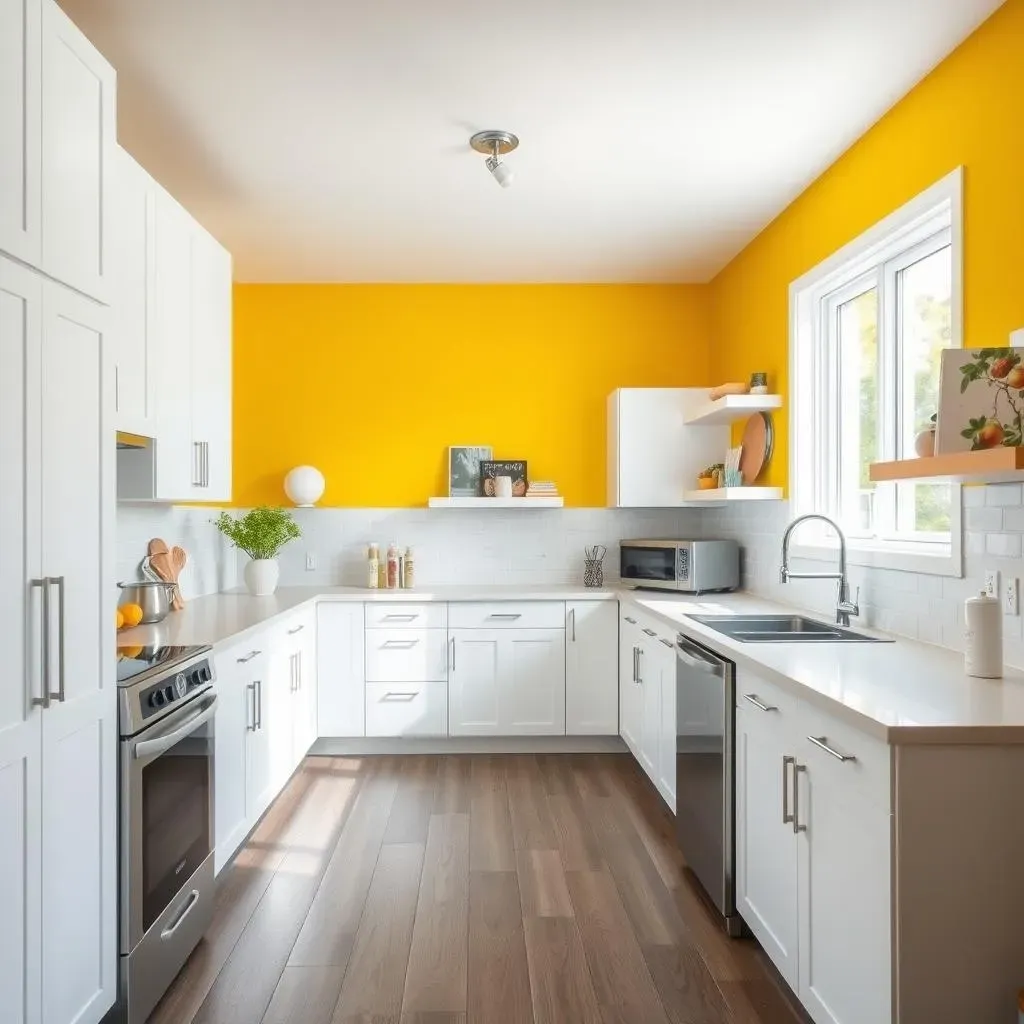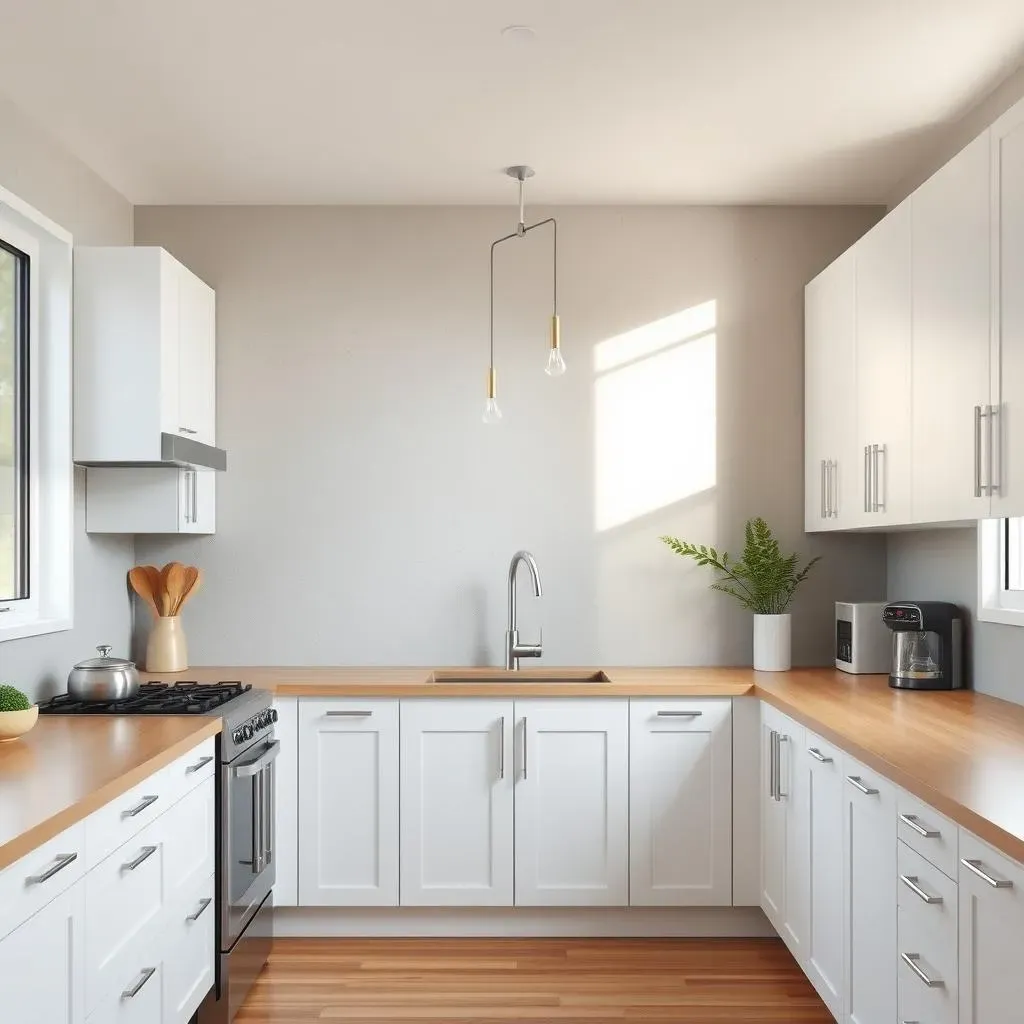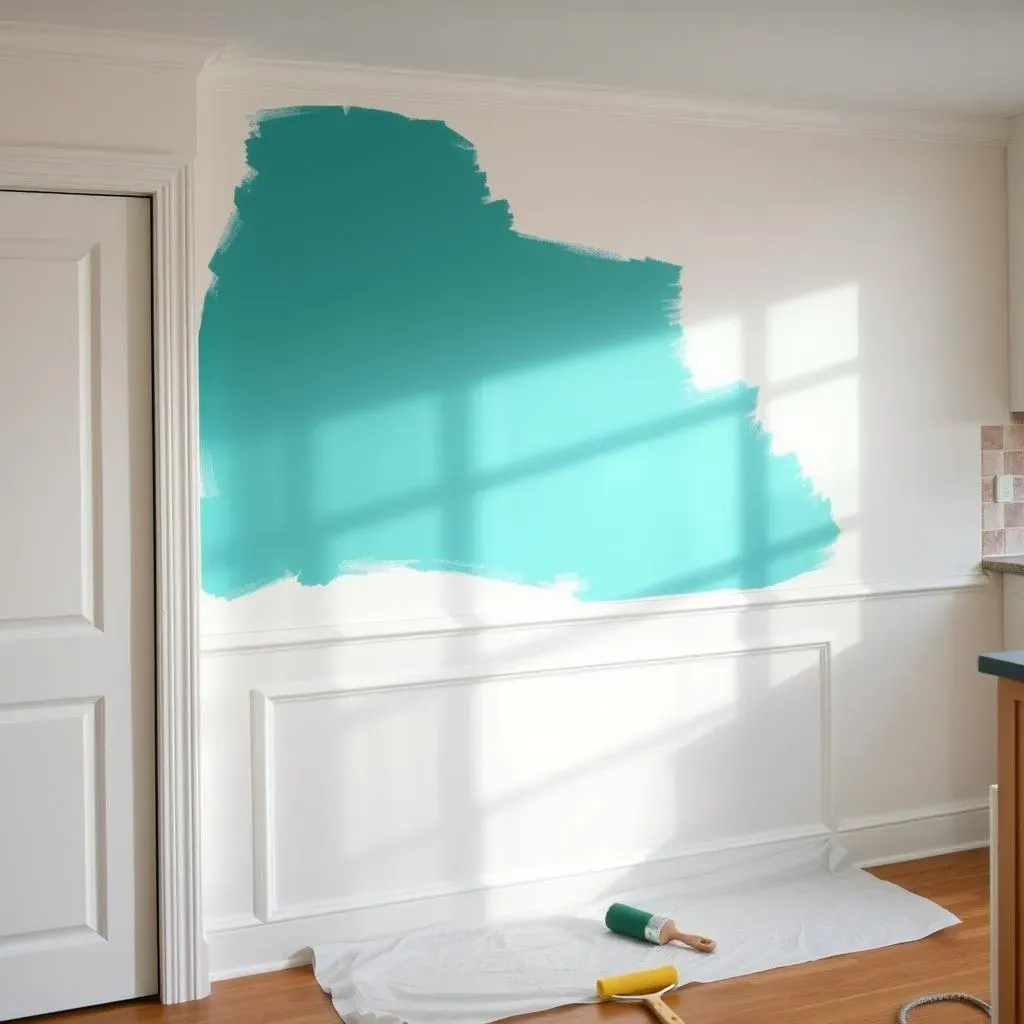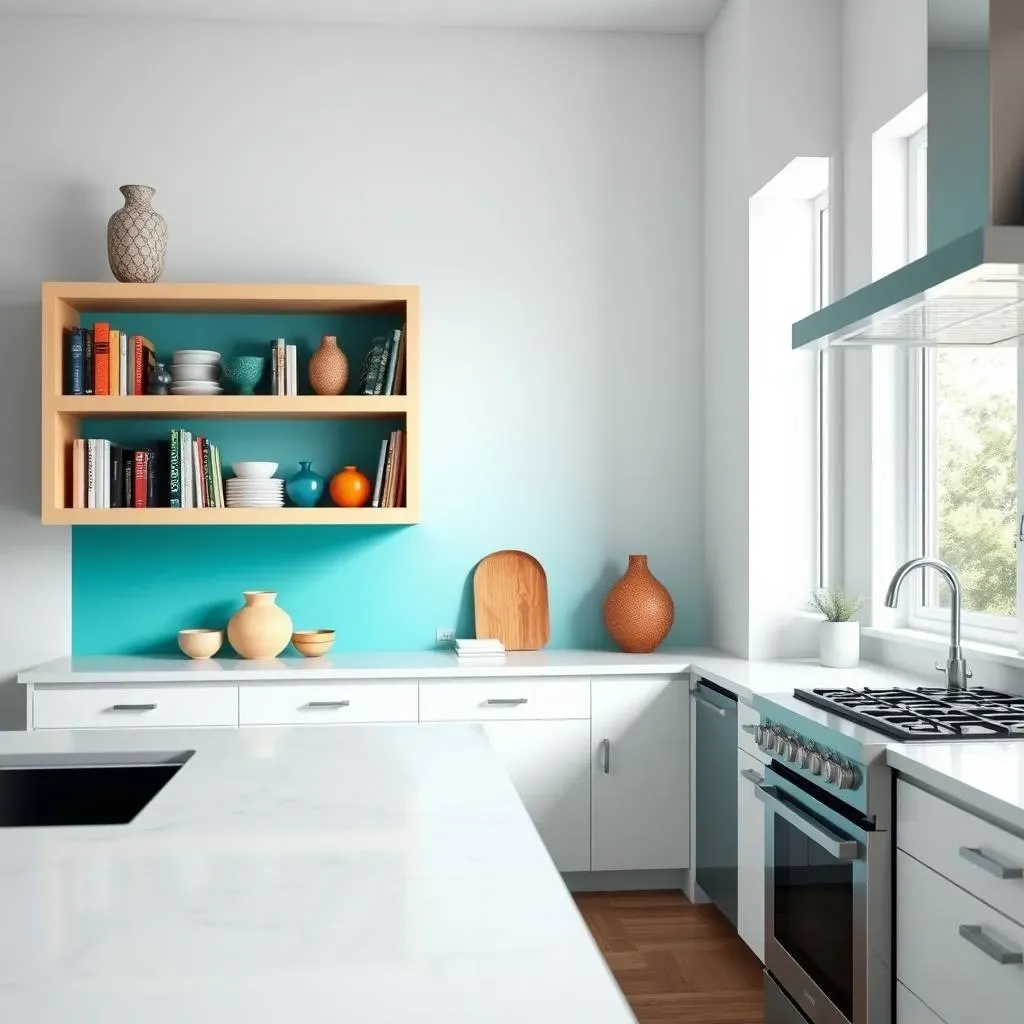Table of Contents
Tired of your kitchen looking like everyone else's? A splash of color can work wonders, and that's where kitchen accent wall paint ideas come in. It's not just about slapping on a new coat; it's about injecting personality, creating a focal point, and completely transforming the feel of your cooking space. Whether you're a seasoned DIYer or just starting to explore the world of home decor, this guide is packed with inspiration and practical tips to help you choose the perfect accent wall. We'll dive into bold and vibrant color choices that can energize your kitchen, explore the subtle elegance of neutral tones and textures, and even venture beyond paint with alternative accent wall materials. Plus, there's a section dedicated to DIY techniques, ensuring you achieve a professional-looking finish. So, grab your paintbrushes and let's get ready to turn your kitchen into a stunning reflection of your style!
Bold & Beautiful: Vibrant Kitchen Accent Wall Paint Colors

Bold & Beautiful: Vibrant Kitchen Accent Wall Paint Colors
So, you're thinking of going bold in the kitchen? Awesome! Forget those beige walls – let's talk about colors that pop. Think about how you want your kitchen to *feel*. Energetic? Go for a sunny yellow or a fiery red. Sophisticated? Maybe a deep emerald green or a rich teal. The key is to choose a color that complements your existing cabinets, countertops, and appliances. Don't be afraid to experiment with paint swatches and see how they look in different lighting conditions. What looks amazing in the store might appear completely different under your kitchen lights.
Consider the size of your kitchen too. A small kitchen might feel overwhelmed by a super-dark color, while a large kitchen can handle a bolder statement. Also, think about the overall style of your home. Does a vibrant color align with the rest of your decor? If you're unsure, start with a smaller area, like the wall behind your open shelving, and see how you like it before committing to a larger space.
Color | Mood | Pairs Well With |
|---|---|---|
Sunny Yellow | Energetic, Cheerful | White cabinets, stainless steel appliances |
Emerald Green | Sophisticated, Fresh | Wooden cabinets, copper accents |
Fiery Red | Passionate, Bold | Black cabinets, granite countertops |
Subtle Statements: Neutral & Textured Kitchen Accent Wall Ideas

Subtle Statements: Neutral & Textured Kitchen Accent Wall Ideas
The Power of Understatement
Not every kitchen accent wall needs to scream for attention. Sometimes, the most impactful designs are those that whisper elegance. Neutral colors, like soft grays, warm whites, and muted beiges, can create a sophisticated and calming atmosphere in your kitchen. These colors work beautifully with a variety of cabinet styles and countertop materials, providing a versatile backdrop for your culinary creations. The beauty of neutrals lies in their ability to enhance the existing features of your kitchen without overpowering them. They reflect light, making the space feel brighter and more open, which is especially beneficial in smaller kitchens.
Think about the undertones of your neutral paint choice. A warm gray with a hint of beige can create a cozy and inviting feel, while a cool gray with blue undertones can lend a more modern and sleek aesthetic. Consider the natural light in your kitchen and how it interacts with the paint color throughout the day. Natural light can significantly alter the appearance of paint, so it's always a good idea to test swatches in different areas of your kitchen before making a final decision.
Texture Takes Center Stage
Want to add depth and visual interest without relying on bold colors? Texture is your answer. Textured paint, such as sand paint or stucco, can create a subtle yet impactful accent wall. These finishes add a tactile element to your kitchen, making it feel more inviting and unique. Another option is to use textured wallpaper, which comes in a wide variety of patterns and materials, from grasscloth to embossed designs. The texture will add a layer of depth that a flat wall simply can't match.
Consider using a stencil to create a subtle pattern on your accent wall. This is a great way to add a touch of personality without overwhelming the space. You can also use natural materials, such as wood planks or stone veneer, to create a textured accent wall. These materials add warmth and character to your kitchen, creating a rustic or farmhouse-inspired feel. Remember to consider the maintenance requirements of textured surfaces, as some may be more difficult to clean than smooth paint.
Texture Type | Effect | Best Paired With |
|---|---|---|
Sand Paint | Subtle grit, earthy feel | Natural wood cabinets, stone countertops |
Grasscloth Wallpaper | Organic texture, calming vibe | Minimalist decor, light-colored cabinets |
Wood Planks | Rustic warmth, natural charm | Farmhouse kitchens, vintage accents |
Balancing Act: Neutral Color Palettes
The key to a successful neutral accent wall is balance. You want to create a focal point without disrupting the overall harmony of your kitchen. Consider incorporating different shades and textures within your neutral palette to add visual interest. For example, you could pair a light gray accent wall with white cabinets and stainless steel appliances. Or, you could use a textured beige paint on your accent wall and complement it with warm wood tones in your furniture and accessories.
Don't forget about the details. The trim color, hardware finishes, and lighting fixtures can all contribute to the overall aesthetic of your kitchen. Choose these elements carefully to complement your neutral accent wall and create a cohesive and stylish space. A well-designed neutral kitchen is a timeless classic that will never go out of style. It's a space where you can relax, cook, and entertain with ease.
DIY Kitchen Accent Wall Paint Techniques & Tips

DIY Kitchen Accent Wall Paint Techniques & Tips
Prep Like a Pro: The Foundation for Flawless Walls
Alright, so you've got your color picked, now it's time to get down to the nitty-gritty. Trust me, a little prep work goes a long way in achieving a professional-looking finish. First things first: clean that wall! Wipe it down with a damp cloth to remove any dust, grease, or grime. Next, grab some painter's tape and carefully tape off all the edges, including the trim, cabinets, and countertops. This will create a clean line and prevent any unwanted paint splatters. Speaking of splatters, protect your floors with a drop cloth or old sheet. You'll thank me later!
Now, inspect your wall for any imperfections, like nail holes or cracks. Fill them in with spackle and let it dry completely. Once the spackle is dry, sand it down smooth with fine-grit sandpaper. This will ensure a seamless finish. Finally, apply a coat of primer to the entire accent wall. Primer helps the paint adhere better and provides a uniform surface for the color to shine. Let the primer dry completely before moving on to the next step.
Pro Tip: Use a high-quality painter's tape to prevent paint bleed. Press the tape firmly against the wall to create a tight seal. If you're painting over a dark color, consider using a tinted primer to help block the old color from showing through.
Step | Action | Why |
|---|---|---|
1 | Clean the Wall | Removes dirt and grease for better paint adhesion |
2 | Tape Edges | Creates clean paint lines and protects surfaces |
3 | Repair Imperfections | Ensures a smooth and flawless finish |
4 | Apply Primer | Improves paint adhesion and color uniformity |
Techniques That Wow: From Basic to Bold
the wall is prepped, the primer is dry, and you're itching to get painting. Let's talk techniques. For a basic, solid color accent wall, start by "cutting in" around the edges with a brush. This means painting a two-inch strip along the trim, ceiling, and corners. Then, use a roller to fill in the rest of the wall. Apply two coats of paint, allowing each coat to dry completely before applying the next. This will ensure even coverage and a rich, vibrant color.
Want to get a little more creative? Consider trying a textured paint technique, like sponging or rag rolling. These techniques add depth and dimension to your accent wall. Another option is to create a geometric pattern using painter's tape. Simply tape off the desired pattern and paint in the sections with different colors. Once the paint is dry, carefully remove the tape to reveal your masterpiece.
- Sponging: Use a sea sponge to apply paint in a random, textured pattern.
- Rag Rolling: Roll a rag over the wet paint to create a unique, distressed look.
- Geometric Patterns: Use painter's tape to create stripes, triangles, or other geometric designs.
Beyond Paint: Alternative Kitchen Accent Wall Ideas

Beyond Paint: Alternative Kitchen Accent Wall Ideas
Tile Tales: From Subway to Statement
so you're not feeling the paint vibe? No problem! Let's talk tile. Forget basic white subway tile (unless you're going for a super minimalist look, of course). Think about bold patterns, vibrant colors, and interesting textures. A mosaic tile backsplash that extends to the ceiling can create a stunning focal point. Or, consider using a geometric tile pattern to add a modern touch. Tile is also super practical in the kitchen, as it's easy to clean and resistant to moisture.
Explore different tile materials, like glass, ceramic, porcelain, and even metal. Each material has its own unique look and feel. Glass tile can add a touch of elegance and sophistication, while ceramic tile is a classic and affordable option. Porcelain tile is durable and water-resistant, making it ideal for high-traffic areas. Metal tile can add a touch of industrial chic to your kitchen.
Tile Type | Style | Pros | Cons |
|---|---|---|---|
Mosaic | Eclectic, Artistic | Adds visual interest, customizable | Can be expensive, requires skilled installation |
Geometric | Modern, Contemporary | Creates a bold statement, adds depth | Can be overwhelming in small kitchens, requires careful planning |
Subway | Classic, Versatile | Affordable, easy to clean | Can be too plain, lacks personality |
Wood Wonders: Warmth and Texture
If you're craving warmth and texture, wood is an excellent choice for a kitchen accent wall. Reclaimed wood planks can add a rustic charm to your kitchen, while sleek wood paneling can create a modern and sophisticated look. Consider using different wood finishes and stains to create a unique and personalized design. You can also incorporate wood shelving into your accent wall to add functionality and storage space.
Wood is a natural insulator, so it can help keep your kitchen warm in the winter and cool in the summer. It's also a sustainable material, especially if you choose reclaimed wood. However, wood is susceptible to moisture damage, so it's important to seal it properly and keep it away from direct water sources. Consider using a water-resistant sealant or varnish to protect the wood from spills and splashes.
Wood Type | Style | Pros | Cons |
|---|---|---|---|
Reclaimed Wood | Rustic, Farmhouse | Adds character, sustainable | Can be expensive, requires careful sourcing |
Wood Paneling | Modern, Sleek | Easy to install, affordable | Can look dated if not done well, requires proper sealing |
Shiplap | Coastal, Contemporary | Adds texture, versatile | Can be difficult to clean, requires regular maintenance |
Wrapping Up Your Kitchen Accent Wall Transformation
So, you've journeyed through a spectrum of kitchen accent wall paint ideas, from vibrant hues to subtle textures and innovative alternatives. Remember, the key is to choose what resonates with your personal style and complements your existing kitchen décor. Whether you opt for a bold statement wall or a more understated design, a well-executed accent wall can breathe new life into your kitchen, making it a space you truly love to be in. Now, go forth and create a kitchen that's as unique and inspiring as you are!
